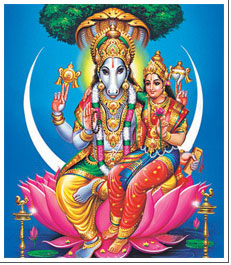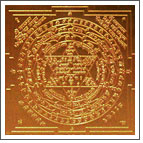
Hayagreeva is an incarnation of Vishnu, depicted with a human body and a horse’s head, brilliant white in color, with white garments, seated on a white lotus.
Hayagreeva is a very important deity in the Vaishnava tradition. His blessings are sought when beginning study of both sacred and secular subjects. Special worship is conducted on the day of the full moon in August (Sravana-Paurnami) (his avatara-dina) and on Mahanavami, the ninth day of the Navaratri festival. He is also hailed as “Hayasirsa”. meaning the Horse (Haya) Sirsa (Headed one) and is considered to be the guru of the goddess of knowledge, Saraswathi.
One of the legends states that during the creation, the demons Madhu and Kaithaba stole the Vedas from the creator Brahma, and to save them Vishnu took the form of Hayagreeva. This story represents the triumph of pure knowledge, guided by the divine over demonic forces of darkness.
Initiation Now Available On Demand
Vedanta Desika’s dhyana-sloka (meditative verse) on Hayagreeva typifies this deity’s depiction in Hindu iconography:
“He has four lotus hands, with one in the mode of bestowing knowledge; another holds books of wisdom, and the other two hold the Conch and Discus. His beauty, like fresh cut crystal, is an auspicious brilliance that never decays. May this Lord of speech who showers such cooling rays of grace on me be forever manifest in my heart! In the Mahavairocana-sutra [Sutra of the Great Sun] translated and copied in 1796 by I-hsing it says: “Beneath the buddhas is Hayagriva. His body is the color of the sun at dawn. He wears flaming effulgence and skulls as a garland. His nails are long and sharp; his face shows a pair of bare tiger’s fangs. His hair is that of a burning lion’s mane. He is awesomely powerful and fierce! This is the fierce Vidyaraja [wrathful vehicle] of the Lotus section.
He is just like a horse-jewel of a Cakravartin that wanders the four continents, nowhere and never does he rest, having all the great and terrible force of all the buddhas’. This is his nature, and therefore he possesses this terrible and all-mighty light. Amidst the greatest obstacles of death and evil he is without the slightest care for his own welfare, his conspicuous and uncommon gallantry, intrepidity, and wrath is legendary among the gods, and therefore he easily and quickly vanquishes all who oppose him! Many others submit to him at first sight! This is because though he is fierce and terrible; his heart is full of compassion (unbiased, dispassionate understanding).” — Hayagriva Stotram, v.32
Later on Hayagreeva is referred to as the “Horse necked one”, “Defender of Faith”, the “Terrible Executioner”, the “Excellent Horse”, and the “Aerial horse”.
This said, the Horse god is seen as pulling the sun up to the heavens every day, bringing light to darkness. Hayagreeva’s consort is Lakshmi (Marici or Kan’non), the goddess of the rising sun, more accurately the sun’s light which is the life force of all things, and which is seen as the female [in, yin] aspect of Hayagreeva. This relationship is the classic non-duality of the Hindu Tantra. Marici represents the essence of the power of creation of the cosmos, and is the in/yin half of Dainichi Nyorai. Whereas, Hayagreeva represents the other yang/yo aspect, that of the manifestation of the power of yin/in as action.
In other words, Hayagreeva represents the manifestation of yin/in as the power and action of the cosmos manifested as action. This is the very definition of Tantra, that of action.
In several other sources he is a white horse who pulls the sun into the sky every morning. In others such as the great epic Taraka-battle where the gods are fallen on and attacked by the danava’s [demons], Vishnu appears as the great ferocious warrior called Hayagreeva when he comes to their aid. It says;
“Hayagreeva appears in his chariot, drawn by 1,000 powerful steeds, crushing the enemies of the gods beneath him!”
There are many other references to Hayagreeva throughout the Mahabharata. It is said that Vishnu comes from battle as a conqueror in the magnificent mystic from of the great and terrible Hayagreeva;
“The great Hayagreeva having been praised in this way by the different saints and ascetics, assumes a great white horses head. The veda’s [mantras] made up his shape, his body built of all the great gods; in the middle of his head was Shiva, in his heart was Bhrama [god of heaven]; the rays of sun (Marici) were his mane, the sun and moon his eyes; the Vashu’s and Sadhya’s were his legs, in all his bones were the gods. Agni [Ka-ten; god of fire] was his tongue, the goddess Satya his speech, while his knees were formed by the Maruts and Varuna. Having assumed this form, a awesome wonder to behold to the gods, he vanquished the asura, and cast them down, with eyes that were red with anger.”
Invariably, Hayagreeva is depicted seated, most often with his right hand either blessing the supplicant or in the vyaakhyaa mudraa pose of teaching. The right hand also usually holds a aksha-maalaa (rosary), indicating his identification with meditative knowledge. His left holds a book, indicating his role as a teacher. His face is always serene and peaceful, if not smiling.
Unlike his Buddhist counterpart, there is no hint of a fearsome side in the Hindu description of this deity. Indeed, the two deities seem to be totally unrelated to one another. Hayagreeva is sometimes worshipped in a solitary pose of meditation, as in the Thiruvanthipuram temple. This form is known as Yoga-Hayagreeva. However, he is most commonly worshipped along with his consort Lakshmi and is known as Lakshmi-Hayagreeva. Hayagreeva in this form is the presiding deity of Mysore’s Parakala Mutt, a significant Srivaishnava monastic institution.
Hayagreeva is an embodiment of intelligence and knowledge. He is a divine being who gives divine intelligence and wisdom. Hayagreeva can also bestow siddhi (Supernatural) powers on you when you connect with his divine energies, with sincerity.
The story of Hayagreeva retrieving the Vedas represents triumph of pure knowledge, guided by the divine, over forces of passion and darkness.
Hayagreeva is an important deity in Vaishnava tradition. His blessings are sought when beginning study of both sacred and secular subject.
Hayagriva is the lord for knowledge. He retrieved the Vedas, the source of knowledge, and hence worshipping him will help one achieve great heights in knowledge.
Hayagreev worship has gained great momentum. It has become a custom to invoke his blessings before the Vidyarambam (commencement of education) ceremony. Students participate in the Hayagreeva homa (fire lab) and seek his blessings before appearing in exams.
The stotram, “Jnananandamayam devam nirmalam spadikaakrudham; Aadhaaram sarva vidyanaaam hayagreeva upasmahe” is a popular Hayagreeva mantra for education.
The two most well-known devotees of lord Hayagreevar are Vedanta Desika and Sri Vadiraja. Sri Vedanta Desika belonged to the 13th century and was a great scholar and an exponent of Sri Vaishnavism. Sri Desika was a master of 64 arts, and has hailed Hayagreevar as a reason for his knowledge.
Sri Vadiraja belonged to the 15th century and belonged to Madhwa sampradaya philosophy. He has greatly devoted himself to Hayagreevar. He daily prepared a specially prasad (food offering) for Lord Hayagreeva, and in turn, lord Hayagreeva took the form of a white horse and appeared daily to eat the special offering.
Both Vedanta Desika and Vadiraja have composed Sri Hayagriva Stotram praising the divine grace and form of Lord Hayagreeva.
There are not too many separate temples for Hayagreevar. Usually, there is a shrine for him in all major Vishnu temples. Below is a list of famous Hayagriva swami temples in India.
Chant the Quantum Sound Frequency given by Dr. Pillai to invoke Hayagreeva’s blessings and grace in your life.
OM AKSHARESHVARAYA VIDHMAHE
MANTRA RAJAYA DHEEMAHE
TANNO HAYA GREEVA PRACHODAYAAT
Alternatively Chant:
Haya Greeva, Haya Greeva, Haya Greeva (pause) and continue
Get a Shiva-Shakti mala, made from rudraksha/crystal beads, and chant this frequency 108 times daily.

Yantras, (Archetypal symbols) are empowered diagrams with squares, triangles, circles in a certain permutation and combination, made in sacred geometry and perfect symmetry. These symbols were used to attract one’s desires and wants. Every archetypal symbol is empowered by its Archetypal being. The Archetypal Symbol is the conduits through with you connect with the Archetypal Being. These empowered diagrams were cognized by the yogic seers in deep states of Samadhi (Mind Process).”
Hayagreeva Yantra contains the power lines that could attract his blessings towards you; the positive radiations enhance your thinking power and kindle your thirst for knowledge. This Archetypal Symbol will communicate your knowledge needs to Hayagreeva and in turn encircle you with positive energy releases strengthening your brain power.
Hayagriva Yantra - Top All the Aptitude Tests! Why Hayagriva Yantra? Hayagriva is an incarnation of Lord Vishnu; he is an embodiment of intelligence and knowledge. If you are yearning to grow in intellect, seek his blessings and power! Your career aspirations and desires will easily get accomplished when you are invigorated with his power. Hayagriva Yantra contains the power lines that could attract his blessings towards you;
Chant the Mantra below in front of the Yantra, preferably after showering.
Om Vagishwaraye Vidmahe
Hayagrivaye Dhimahi
Tanno Hayagrivah Prachodayat
Alternatively
OM AKSHARESHVARAYA VIDHMAHE
MANTRA RAJAYA DHEEMAHE
TANNO HAYA GREEVA PRACHODAYAAT
Alternatively Chant:
Haya Greeva, Haya Greeva, Haya Greeva (pause) and continue
Note: The specified Mantra is to be recited for 108 times as a standard rule; however, changes if any will be mentioned at the time of buying.